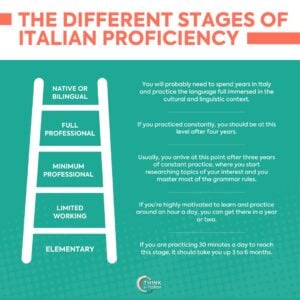Welcome to the Italian subjunctive!
Even some native speakers make mistakes and use the subjunctive incorrectly. So, using it correctly will make you seem smart, and you’ll probably receive compliments.
Anyway, don’t worry about making mistakes when you first try to put them into practice. Italians will still understand what you mean if you use it incorrectly.
Just so you know, the congiuntivo consists of four tenses: presente, passato,imperfetto, and trapassato.
In this lesson, we’re going to focus on the congiuntivo presente, which is the present of the subjunctive, and we’ll go little by little.
What’s the subjunctive?
The subjunctive is a verbal mood, a verb category, like the indicative. We use the present of the subjunctive to talk about hopes, hypotheses, desires, fears, possibilities, and doubts.
We find it mostly after the main clause, and it’s usually preceded by the conjunction che.
You’ll notice that the presence of the subjunctive in Italian doesn’t always translate into the present tense. This is because it depends on what you want to say.
Let’s have a look at some examples. Make sure you pay attention to the purpose of each sentence (whether it is to talk about hope, desire, doubt, etc.).
Voglio che tu sia felice.
I want you to be happy.
Spero che loro stiano meglio.
I hope they are better.
Ho paura che mia sorella perda il lavoro.
I’m scared my sister might lose her job.
È possibile che le cose non vadano bene.
It’s possible that things won’t go well.
How to conjugate regular verbs?
To form the present of the subjunctive in Italian, you have to keep the root of the verb in the present of the indicative (parl-, ved-, part– if we take the roots of the verbs below) and add the correct endings, which are in bold in the table below:
| parlare | vedere | partire | |
| io | parli | veda | parta |
| tu | parli | veda | parta |
| lui/lei | parli | veda | parta |
| noi | parliamo | vediamo | partiamo |
| voi | parliate | vediate | partiate |
| loro | parlino | vedano | partano |
You probably noticed the following aspects:
- for io, tu and lui/lei the ending is the same.
- for noi (parliamo, vediamo, partiamo), the subjunctive looks exactly like the present of the indicative (which means you probably won’t get it wrong) same for tu parli
- for voi and in parlino the presence of the letter i
Let’s have a look at some examples:
Mi sembra che lei non parli sul serio.
I think she’s not talking seriously.
Non credo che Marco veda bene.
I don’t think Marco can see well.
Anna non vuole che i nonni partano.
Anna doesn’t want her grandparents to leave.
Lei preferisce che io compri questa casa.
She prefers that I buy this house.
Non voglio che tu creda a quello che ti dicono.
I don’t want you to believe what they tell you.
Spero veramente che vi sentiate meglio.
I really hope you feel better.
Practice with Quizlet
Here's a set of flashcards and quizzes to practice this grammar topic.What are some common phrases preceding the subjunctive?
You probably already noticed this (and if not, you can check above) some key phrases are followed by the subjunctive.
When they’re negative, they are also followed by the subjunctive.
Here they are:
- Penso che: I think that
- Credo che: I believe that
- Spero che: I hope that
- È possibile che: It’s possible that
- Sembra che: It seems that or It seems like
Other than the conjunction che, you’ll find the subjunctive after the following phrases:
- a meno che non: unless
- affinché: so that
- prima che: before
- purché: provided that
- salvo che: unless
- senza che: without
Here are some examples:
Lei vuole venire a meno che tu non parli sul serio.
She wants to come unless you’re not talking seriously.
Compra il biglietto prima che cambi idea.
Buy the ticket before I change my mind.
Va bene purché tu dica la verità.
It’s fine, provided that you tell the truth.



















